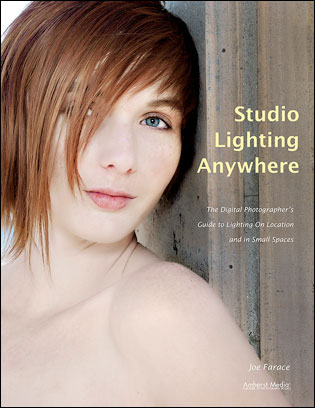My Sunday series on outdoor portraiture continues today with an image of legendary Internet model Anna Lieb who I photographed at a group model shoot, as has been the case with some other models appearing in this series. Today’s feature image is from the second time I photographed her.
Today’s Post by Joe Farace
Beauty and femininity are ageless and can’t be contrived, and glamour, although the manufacturers won’t like this, cannot be manufactured. Not real glamour; it’s based on femininity. —Marilyn Monroe
I’ve always believed the best way to improve your photographic skills was by practicing. It’s a good idea to photograph anything each week, it doesn’t even have to be a portrait. The idea is that by actually making photographs you will reach a point where you don’t have to think about how to operate your camera’s controls. You’ll just use it. Don’t worry about producing masterpieces either. Use your camera as a sketchpad to explore possibilities and don’t be afraid of making mistakes. Sometimes these “sketches” will be successful, sometimes not but take the opportunity to learn by analyzing what the images look like and how they fit into your vision of the world.
Some tips that can help:
Look for locations where the light is best. Many photographs are made in locations without considering the kind of lighting conditions the photographer and model might encounter. Not long ago, there was an on-line discussion about what inspires people to create new images. For me, it’s new things. It can be a new camera, new lens, or just a new place to make images. When driving around I make notes about locations that could serve as a location for a portrait session but being always mindful about the lighting conditions.
 How I Made this Portrait: I made this outdoor portrait of the incredible Ann Lieb at a group model shoot in Phoenix, Arizona. The portrait was made using a Canon EOS 10D with an EF 28-105mm f/3.5-4.5 II USM lens (at 83mm) with an exposure of 1/80 sec at f/8 and ISO 200. A Canon Speedlite 420EX was used for fill, yet the image was slightly underexposed. I used a modified approach similar to what’s explained in my post How to Correct Underexposed Portraits to correct it. The wonderfully useful EF 28-105mm f/3.5-4.5 II USM lens has been discontinued but you can pick up a used one from all the usual suspects
How I Made this Portrait: I made this outdoor portrait of the incredible Ann Lieb at a group model shoot in Phoenix, Arizona. The portrait was made using a Canon EOS 10D with an EF 28-105mm f/3.5-4.5 II USM lens (at 83mm) with an exposure of 1/80 sec at f/8 and ISO 200. A Canon Speedlite 420EX was used for fill, yet the image was slightly underexposed. I used a modified approach similar to what’s explained in my post How to Correct Underexposed Portraits to correct it. The wonderfully useful EF 28-105mm f/3.5-4.5 II USM lens has been discontinued but you can pick up a used one from all the usual suspects
Keep your lighting simple. For available light portraits, I like to work with as few lights as possible because the less time spent fiddling with equipment, the more time you can spend putting your subject at ease. That is especially important for portraits. My available light portraits are sometimes made with an old, inexpensive 32-inch double-sided reflectors that collapses to the size of a large pizza. A compatible speedlight, like the 420EX I used for this portrait, is my constant companion on outdoor model shoots.
Watch the background. It’s so easy to become so enthralled by the person you’re photographing you forget about the background where you’ve placed them. I think if you watch the background, the foreground will take care of itself. Busy backgrounds can be thrown out of focus with longer focal length lenses and/or wide apertures but it’s not a bad idea to physically clean up an outdoor site before you can make a portrait.
Talk to your subject. I’ll never forget the advice one of my mentors gave me many years ago. When I asked what was the worst thing I could do when photographing people, I expected him to give me some technical tip but his answer surprised me. “If you don’t talk to the people you’re never going make a good picture.” I’ve never forgotten that advice and want to pass it on to you.
Photographing people combines elements of psychology as much as camera technology and how you personally interact with your subject will have a lot more to do with the success of your session than the camera or lens you decide to use.

For more tips, tricks and techniques for creating studio lighting effects without spending the big bucks on gear, please pick up a copy of my book Studio Lighting Anywhere, which features a cover photograph by Mary Farace. It’s available used from Amazon for around $33, as I write this. The Kindle version is only $19.99 for those preferring a digital format.